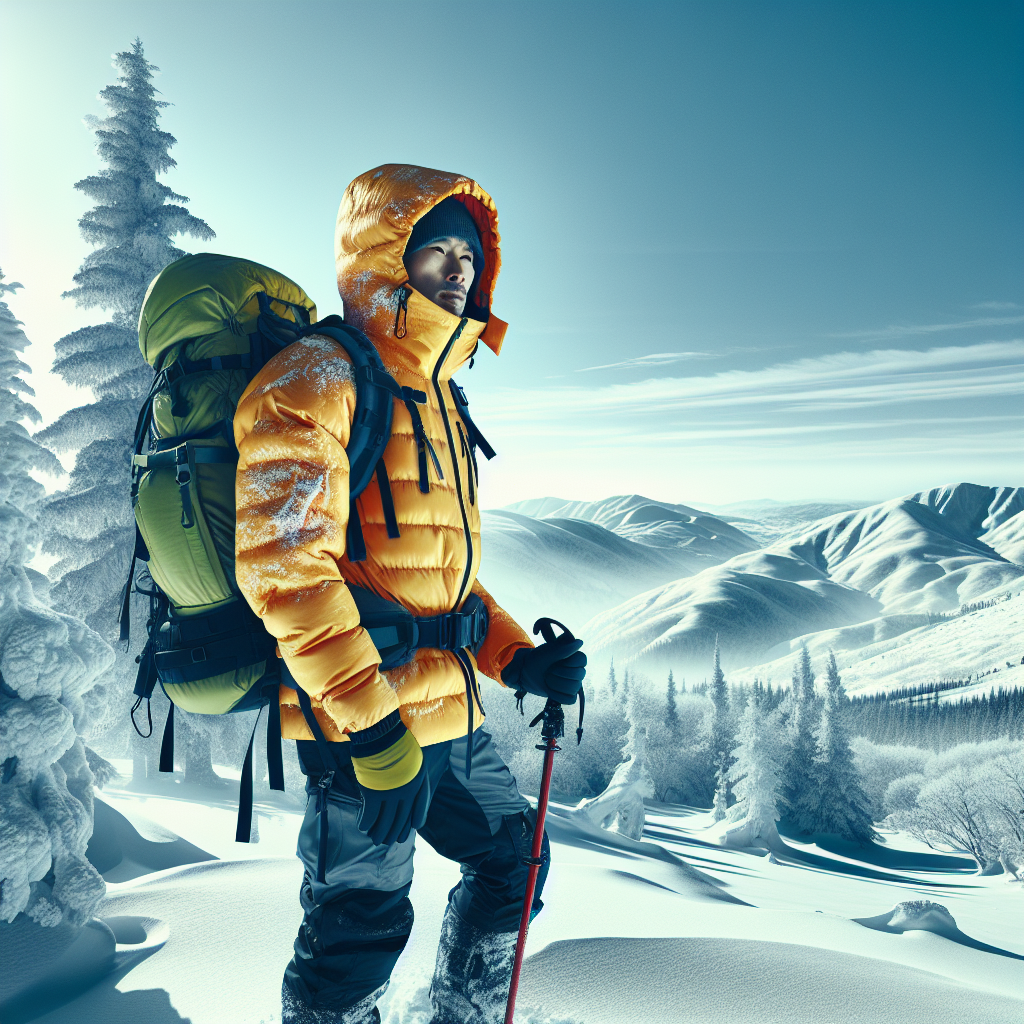If you’ve ever dreamed of being one with nature during the harsh winter months, then using the right gear and respecting safety guidelines will be key. This article titled “Hiking In Winter: Cold Weather Gear And Safety” will equip you with the necessary details and handy tips. As your companion in challenging the winter elements, it will guide you through selecting the right clothing and equipment to ensure warmth and safety. Plus, you’ll find thoughtful advice on how to navigate through potential hazards and emergencies, making your winter hiking experience a memorable one.

Understanding the Risks of Winter Hiking
Winter hiking can be a uniquely fulfilling experience, providing you with stunning, snow-draped landscapes and an added level of tranquility. But it’s important to remember the inherent risks involved with tramping in cold conditions.
The Challenge of Cold Temperatures
Your body will have to work extra hard to maintain its core temperature when you’re out in the frigid temperatures. This not only makes simple tasks more strenuous but may result in certain dangerous health conditions if you get too cold.
The Risk of Hypothermia
Hypothermia occurs when your body loses heat faster than it can produce, causing a dangerously low body temperature. This could happen when you’re stationary for too long in the cold or your clothing gets wet. In severe cases, it can lead to heart and respiratory failure or even death.
The Danger of Frostbite
Frostbite is another serious concern in winter conditions. It happens when skin and the tissue beneath freeze – especially on your extremities like fingers, toes, ears, and nose. It’s crucial to keep these body parts adequately covered and warm.
Greater Energy Consumption
When hiking in cold conditions, your body burns more calories due to the extra effort required to stay warm and navigate through deep snow or slippery terrain. This necessitates carrying more food for energy and taking regular breaks to rest and refuel.
Importance of Weather Forecasting
Weather plays a crucial role in winter hiking and, unlike other outdoor activities, getting caught in a storm could prove fatal.
Understanding Weather Pattern
Learning about winter weather patterns can help you anticipate weather changes and stay ahead of the curve. You’ll start recognizing tell-tale signs and avoid getting caught off-guard.
Importance of Checking Local Forecast
Always check local forecasts before you leave. Be sure to look for information on temperature, wind speed, precipitation, and snow conditions. The weather can change rapidly in winter, making it important to stay updated during your trip.
Adjusting Plans According to Forecast
Your safety should always take priority over your hiking plans. If the weather forecast predicts severe conditions, it’s best to postpone your hike or choose a less challenging route rather than risk getting caught in a storm.
Carrying Weather-appropriate Gear
Carrying the right gear for the forecasted weather can be a lifesaver. Whether it’s an umbrella for sleet, micro-spikes for icy trails, or a warm hat for a sudden drop in temperature, being prepared can make all the difference.
Layered Clothing for Winter Hiking
Dressing appropriately is crucial for winter hiking. The best strategy to maintain a comfortable and safe body temperature is layering.
The Base Layer: Moisture Management
The base layer sits right against your skin and is responsible for moisture management. It should be made of wool or synthetic materials that wick sweat away, keeping you dry and thereby warm.
The Middle Layer: Insulation
The middle layer(s) provide insulation by trapping warm air close to your body. Fleece or down jackets work well for this. Ensure your insulating layer is breathable to allow excess heat and moisture to escape.
The Outer Layer: Wind and Water Protection
Your outer layer should be a waterproof and wind-resistant shell that protects you from snow, sleet, and wind-chill.
Layering Principles and Strategy
Remember, the idea of layering is to add or remove layers depending on your activity level and the weather. Dressing in removable layers helps manage your body temperature and prevent overheating and excessive sweating, which can lead to a chilling effect.
Specific Winter Gear Recommendations
To have a safe and enjoyable winter hiking experience, it’s recommended to invest in specific gear designed for cold conditions.
Insulated Footwear
Winter hiking boots should be waterproof and insulated yet breathable, maintaining comfort while preventing frostbite.
Gloves and Mittens
Invest in quality insulated gloves or mittens. Mittens often offer greater warmth than fingered gloves by keeping your fingers in closer contact.
Hats and Neck Warmers
A lot of body heat is lost through the head and neck, making hats and neck warmers vital pieces of your winter closet.
Gaiters and Crampons
Gaiters keep snow out of your boots, while crampons give you the extra grip needed to navigate icy terrains safely.
Use of Hiking Poles
Hiking poles provide added stability and balance on slick, icy trails, and are almost a necessity for winter hiking.

Importance of Hydration and Nutrition
Maintaining proper hydration and nutrition is key to staying energetic and avoiding fatigue on a winter hike.
Preventing Dehydration in Cold Weather
You may not feel as thirsty in cold weather, but winter hikes can dehydrate you due to high energy expenditure and the drier air. Drink water regularly throughout the hike.
Selection of Hydration Equipments
Insulated water bottles or hydration bladders can prevent your water from freezing. Hot drinks such as herbal teas or hot chocolate can also assist in keeping warm.
Winter-Friendly Foods and Snacks
Pack high-calorie, easy-to-eat foods and snacks. Foods that don’t freeze and can be consumed easily – like cheese, nuts, or energy bars – are good choices.
Understanding Calorie Consumption During Winter Hiking
Remember that your body burns more calories in cold weather. So, eat more than your usual hiking diet to ensure your energy levels remain high.
Guidance on Snow and Ice Travel
Navigating in snowy and icy conditions can be quite a challenge. Here’s how you can do it safely.
Understanding Types of Snow
Snow conditions vary greatly, from fluffy powder to hard-packed ice. Understanding the type of snow can help you adjust your pace and know when to use your crampons or snowshoes.
Walking Over Ice Safely
Always test icy surfaces with a hiking pole before stepping on them. Crampons or micospikes can be used for better grip and prevent slipping.
Preventing Slips and Falls
Ensure you’re using appropriately-sized crampons and/or hiking poles to prevent slips and trips. Practice moving slowly and steadily, especially on tricky terrains.
Specialized Gear for Ice and Snow
Consider using specialized gear like ice axes, crampons, and snowshoes to make your hikes safer during the winter months.
Winter Navigation Skills
Winter landscapes can be tricky to navigate due to snow obscuring known trails and landmarks.
Reading Winter Terrains
Understanding how snow and terrain interact can help you read winter landscapes. Look out for potential avalanche areas, wind-loaded slopes, and other risky areas.
Navigating in Low Visibility
Snowfall and fog can lower visibility. Navigating then requires reliance on compass bearings and GPS waypoints, in conjunction with physical terrain features.
Orientation using Map and Compass
A map and compass are your best friends when it comes to navigating in the wilderness. Over-reliance on electronics can be detrimental, as devices can fail or run out of battery.
GPS and Electronic Navigation Devices
GPS and other electronic devices, if available, can be highly useful in navigating. However, always have a traditional map and compass as backups.
Recognizing and Dealing with Cold-related Injuries
Knowing how to identify and treat cold-related injuries can save lives.
Signs and Symptoms of Hypothermia
Hypothermia symptoms may include shivering, exhaustion, confusion, and even a lack of shivering in advanced stages. If you suspect hypothermia, take action to warm up immediately.
First Aid for Frostbite
Frostbite presents as numbness and pale, cold, hard skin. If you suspect frostbite, begin warming the area gradually, preferably with body heat or warm (not hot) water.
Preventing Cold Injuries
Prevention is the best medicine. Dress properly, keep dry, move continuously (but don’t overexert), and eat and drink regularly to keep your body fueled and heated.
Tips for Rapid Warming
Carry a small stove to heat water for warm drinks and instant meals, a reliable fire-starting kit for emergency heat and light, and extra warm clothing.
Building Winter Shelters
If an unforeseen situation demands an overnight stay, knowing how to build a shelter can protect you from the elements.
Selecting a Good Shelter Location
Choose a location with some natural protection like tree cover. Avoid windy ridges, avalanche paths, and areas near water bodies that may cause your shelter’s temperature to drop lower.
Building a Snow Cave
If snow conditions permit, a well-made snow cave can be a warm and safe shelter. Plan your layout carefully, dig upwards for better insulation, and always ventilate your cave.
Setting up a Tent in Snow
When setting up a tent in snowy conditions, compact the snow under your tent, dig a small pit for cold air to settle, and secure your tent with snow stakes or anchors.
Emergency Shelters and Bivouacs
In case of emergencies, carry lightweight shelters like bivvy sacks. These can be set up quickly and provide temporary protection from cold and wind.
Leaving No Trace and Respecting the Environment
As you enjoy the pristine winter landscape, it’s important to respect nature by following “leave no trace” principles and ethical hiking practices.
Minimizing Campfire Impact
Use a lightweight stove for cooking instead of making a fire if possible. If you must make a fire, use established fire rings and keep fires small.
Proper Waste Disposal
Pack out all trash, leftover food, and litter. Bury human waste in deep snow, well away from trails, campsites, and water sources.
Protecting Wildlife
Avoid disturbing wildlife. Remember, winter is a critical season for many animals and they need to save their energy to survive.
Respecting Other Visitors and Local Communities
Respecting others includes keeping noise levels low, maintaining considerate behavior, and yielding to other hikers on the trail. Also, keep in mind the local customs and livelihoods of local communities, especially if you’re hiking in remote areas.
By understanding the risks, gearing up appropriately, improving your skills, and respecting nature, you can make winter hiking a rewarding and unforgettable experience.

